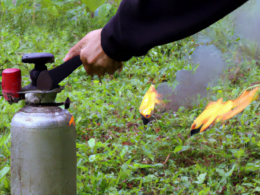Do you want to make your painted surfaces safer and more slip-resistant? Adding sand to paint is a simple and effective way to achieve a non-slip surface, ensuring the safety of you and your loved ones.
By following a few easy steps, you can create a non-slip paint that provides traction and reduces the risk of accidents.
First, gather the materials you’ll need, including sand and your chosen paint.
Next, prepare the surface by cleaning and priming it to ensure proper adhesion.
Then, mix the sand with the paint, creating a textured mixture that will enhance grip.
Apply the non-slip paint to the surface using a roller or brush, making sure to cover the area evenly.
Allow the paint to dry completely before testing the surface for slip resistance.
Maintaining and cleaning the non-slip surface is crucial to its longevity, so be sure to follow proper maintenance guidelines.
By adding sand to your paint, you can enjoy a safer environment, free from the worry of slips and falls.
Start making your surfaces slip-resistant today and prioritize safety in your home or workplace.
Quick Summary
- Adding sand to paint creates a non-slip surface
- Sand with a coarse texture and evenly sized grains is recommended
- Regular maintenance and cleaning of slip-resistant surface is crucial
- Sand in paint transforms any surface into a non-slip haven
Gather the Materials You’ll Need
To begin the process, gather all of the necessary materials you’ll need. Safety should be your top priority, so make sure you have the right equipment.
You will need sand, paint, a mixing container, a paintbrush or roller, and a measuring tool.
Choosing the right type of sand is crucial for making your paint non-slip. Look for sand that has a coarse texture and grains that are evenly sized. Avoid using fine sand as it may not provide enough traction. You can find sand at your local hardware store or online.
Next, you need to determine the proper sand to paint ratio. This will depend on the level of traction you desire. A general rule of thumb is to mix one part sand with every four parts of paint. However, if you want a more textured surface, you can increase the amount of sand. Just be careful not to overdo it, as too much sand may affect the paint’s consistency.
Once you have gathered all the materials and determined the right sand to paint ratio, you’re ready to mix them together. Pour the desired amount of paint into your mixing container, then gradually add the sand while stirring continuously. Make sure the sand is evenly distributed throughout the paint.
Now you’re ready to apply the non-slip paint to your desired surface. Use a paintbrush or roller to evenly coat the area, making sure the sand is spread out uniformly. Allow the paint to dry completely before using the surface.
By following these steps and using the right materials, you can easily add sand to your paint to create a non-slip surface that enhances safety.
Prepare the Surface for Painting
Before you begin painting, make sure the surface is properly prepared to create a safe and secure footing. Surface preparation is crucial for making your paint non-slip. Here are a few steps you should follow to ensure a successful and safe application.
-
Clean the surface: Remove any dirt, dust, or debris from the area you plan to paint. Use a broom or vacuum to get rid of loose particles, and then wipe the surface down with a damp cloth to remove any remaining residue.
-
Repair any damage: Inspect the surface for cracks, holes, or uneven areas. Fill in any gaps with a suitable filler and smooth it out using a putty knife. This will ensure a smooth and even surface for your paint to adhere to.
-
Prime the surface: Applying a primer is essential for proper adhesion of the paint. Choose a primer specifically designed for the surface you are painting, such as a masonry primer for concrete or a wood primer for wooden surfaces. Apply the primer according to the manufacturer’s instructions, and allow it to dry completely before proceeding with the paint application.
By taking the time to properly prepare the surface and apply a primer, you’re ensuring that your paint will adhere well and provide the non-slip properties you desire. This will create a safe and secure footing, giving you peace of mind.
Mix the Sand with the Paint
Mixing sand into the paint creates a textured surface that provides extra grip and traction, making it an excellent choice for those who prioritize safety.
There are several benefits of using sand as a non-slip agent in paint. Firstly, it enhances the overall durability of the paint, making it resistant to wear and tear. Additionally, the added texture helps to prevent slips and falls, particularly in areas that are prone to moisture, such as bathrooms, kitchens, or outdoor walkways.
When it comes to choosing the right type of sand for your non-slip paint mixture, there are a few options to consider. One popular choice is silica sand, which is made up of small, fine particles that create a smooth and even texture when mixed with paint. Another option is pumice sand, which has larger particles that provide a more aggressive texture for enhanced traction. Additionally, you can also opt for a combination of different sands to achieve a desired level of grip and aesthetics.
Remember, safety should always be a priority when working with non-slip paint mixtures. Be sure to follow all instructions provided by the manufacturer and take necessary precautions to protect yourself during the mixing and application process.
Apply the Non-Slip Paint to the Surface
Once the surface is properly prepared, it’s crucial to apply the non-slip paint carefully and evenly. This step is essential to ensure maximum safety and prevent any potential accidents. Whether you’re applying non-slip paint on stairs or outdoor surfaces, here are a few tips to help you achieve the best results:
-
Start by using a high-quality paintbrush or roller to apply the non-slip paint. This’ll help ensure an even coat and proper coverage.
-
Work in small sections to ensure that the paint doesn’t dry before you have a chance to sprinkle the sand onto it.
-
Sprinkle the desired amount of sand onto the wet paint, making sure to cover the entire painted surface. The sand’ll provide the necessary texture to make the surface non-slip.
-
Gently press the sand into the paint using a clean brush or roller to ensure that it adheres properly.
-
Allow the paint to dry completely before using the surface. This’ll ensure that the non-slip properties have fully developed and’ll provide the best traction.
By following these steps and incorporating non-slip paint into your surfaces, you can create a safer environment and reduce the risk of slips and falls. Remember, safety should always be a top priority when it comes to any surface that may be prone to slipping.
Allow the Paint to Dry
After patiently waiting for the paint to dry, you’ll be amazed at the transformation and relieved knowing that your surfaces are safer than ever before. The drying process is crucial as it allows the non-slip paint to fully adhere to the surface, ensuring its effectiveness.
Once the paint has completely dried, you can confidently walk on the treated area without worrying about slipping or falling.
There are different types of non-slip paint available, each with its own benefits and drawbacks. One type is epoxy-based paint, which provides a durable and long-lasting non-slip surface. It’s resistant to chemicals and can withstand heavy foot traffic. However, the application process can be more complex and time-consuming compared to other types of non-slip paint.
Another option is acrylic-based paint, which is easier to apply and dries quickly. It offers good non-slip properties and is suitable for both indoor and outdoor use. However, it may not be as durable as epoxy-based paint and may need to be reapplied more frequently, especially in high-traffic areas.
Regardless of the type of non-slip paint you choose, allowing it to dry completely is essential for optimal results. So, resist the temptation to rush the process and give the paint ample time to dry. Once it’s dry, you can enjoy the benefits of a safer and more secure surface.
Does Adding Sand to Paint Help in Removing Paint Splatter from Brick?
Adding sand to paint can indeed assist in getting rid of paint splatter from brick surfaces. The coarse texture of the sand helps to create a gritty consistency that aids in scrubbing away stubborn paint splatter. When applied to a brick surface, the sand-infused paint can effectively remove the splatter, restoring the brick’s original appearance.
Can Adding Sand to Paint Help Prevent Rust on Outdoor Furniture?
Adding sand to paint may not directly remove rust from outdoor furniture, but it can help prevent rust formation. The sandy texture of the paint creates a rough surface that makes it harder for moisture to settle, reducing the chances of rust. Regular maintenance and proper rust prevention techniques are still necessary for keeping outdoor furniture in optimal condition.
Test the Surface for Slip Resistance
Now that you have allowed the paint to dry, it’s time to test the surface for slip resistance. This step is crucial in ensuring the safety of your space, as slip-resistant surfaces are essential for preventing accidents and injuries.
To conduct slip resistance tests, you will need a few materials such as a slip resistance tester and a sample of the painted surface. Place the tester on the painted area and apply pressure while walking on it. The device will measure the coefficient of friction, indicating the level of slip resistance.
It is important to remember that slip resistant surfaces are especially vital in areas prone to moisture or where there is a higher risk of slips and falls. By adding sand to your paint, you have taken a proactive step in creating a safer environment. Incorporating slip resistance tests into your painting process ensures that you have achieved the desired level of safety.
By following these steps and conducting slip resistance tests, you can be confident that your painted surface will provide the necessary traction to prevent accidents. Remember, safety should always be a top priority.
Maintain and Clean the Non-Slip Surface
To keep your slip-resistant surface in top condition, it’s crucial to regularly maintain and clean it. Cleaning techniques play a crucial role in preserving the non-slip properties of the surface and ensuring its effectiveness.
When it comes to cleaning, it’s important to choose the right sand particles that are compatible with the paint and provide optimal slip resistance.
To maintain the non-slip surface, start by regularly sweeping away any dirt, debris, or leaves that may accumulate on the surface. This will prevent these particles from affecting the texture and grip of the surface. Additionally, use a soft-bristled brush or mop to gently scrub the surface with a mild detergent and water solution. Avoid using harsh chemicals or abrasive cleaners as they can damage the non-slip coating.
When choosing the right sand particles to add to your paint, consider the size and texture. Finer sand particles tend to provide a smoother surface, while coarser particles offer more grip. It’s important to strike a balance between the two to achieve the desired level of slip resistance without compromising on comfort.
Regular maintenance and cleaning using appropriate techniques and the right sand particles will help ensure the longevity and effectiveness of your non-slip surface, providing you and others with a safe and secure environment.
Enjoy a Safer Environment
Experience the peace of mind that comes with walking on a surface that ensures your safety and provides a secure environment. By adding sand to paint, you can increase traction and reduce accidents, creating a non-slip surface that offers protection for you and your loved ones.
With this simple modification, you can enjoy a safer environment in various areas of your home or workplace. Here are three reasons why this solution will evoke an emotional response:
-
Enhanced Stability: Feel confident as you move around, knowing that the added sand in the paint creates a textured surface that improves grip. No more worrying about slipping and falling, especially in high-traffic areas like hallways or staircases.
-
Peace of Mind for Children and Elderly: Ensure the safety of your little ones and older family members by providing a non-slip surface. Whether they’re playing or simply going about their daily activities, the added traction will give you peace of mind, knowing that accidents are less likely to occur.
-
Protection in Wet Conditions: Rainy days or spills are no longer a cause for concern. The sand-infused paint adds an extra layer of protection, increasing traction even when the surface is wet. This means you can confidently walk on the surface without the fear of sliding.
By incorporating sand into your paint, you can transform any surface into a non-slip haven, increasing traction and reducing accidents. Enjoy the safety and security that comes with a textured surface and embrace the peace of mind it brings to your everyday life.
Frequently Asked Questions
How does adding sand to paint make it non-slip?
Adding sand to paint creates a non-slip surface by increasing friction. This prevents accidents caused by slippery surfaces. However, the disadvantages include a rough texture and difficulty in cleaning. Alternative methods include using non-slip additives or textured paints. Stay safe!
What type of sand should I use for this project?
For this project, use fine-grain silica sand. It provides excellent slip resistance and doesn’t affect the color of the paint. Adding sand to paint enhances safety by preventing slips and falls.
Can I mix sand with any type of paint or are there specific types that work best?
When it comes to making paint non slip, you can mix sand with most types of paint. However, it’s important to use sand additives that are specifically designed for different types of paint. The pros of using sand in paint include added traction and safety, but the cons include a rougher texture and more difficult cleaning.
How long does it take for the non-slip paint to dry?
The drying time of non-slip paint depends on various factors like humidity and temperature. Generally, it takes around 24 to 48 hours to dry completely. Follow proper application techniques for a safe and effective result.
How often do I need to clean and maintain the non-slip surface?
To maintain a non-slip surface, clean it regularly using a mild detergent and water. Focus on removing dirt, grease, and debris that can reduce traction. Inspect for any damage and repair promptly for optimal safety.
Conclusion
So there you have it, adding sand to paint is a simple and effective way to create a non-slip surface. By following these steps and taking the time to properly prepare and apply the paint, you can enjoy a safer environment with reduced slip risk.
Remember to regularly maintain and clean the non-slip surface to ensure its longevity. Now you can confidently walk on your painted surfaces without worrying about slipping or accidents. Stay safe!








